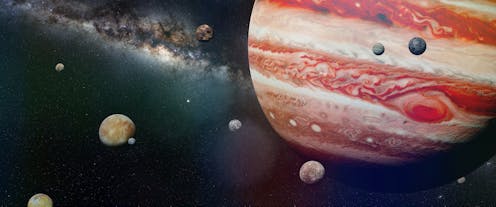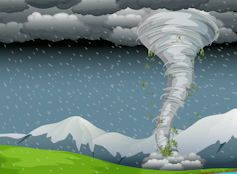
Will the big storm on Jupiter ever go away? — Edgar Nuttall, age 5, Brisbane
Hi Edgar! Thank you for such a unique question.
Jupiter is the largest planet in our solar neighbourhood, and its weather is very wild. We have beautiful images of Jupiter which show striped, stormy clouds covering the whole planet.
In fact, Jupiter is covered with storms. Some are only small, but some are so big they could cover all of Earth.
The largest of these storms is the famous Great Red Spot — which I see you already know about. This spot is actually a cyclone, similar to hurricanes and cyclones here on Earth.
It is made of powerful winds blowing in circles, a bit like tea swirling in a cup when you stir it. These winds are more than five times faster than any hurricane winds on Earth.
The Great Red Spot is like the grandfather of Jupiter’s storms. It has been roaming for many, many years – but recently we’ve seen it get smaller.
Does that mean it will one day go away? Well, not necessarily.
Stormy stripes
Jupiter looks like a giant, stripy ball that spins very fast. The light-coloured stripes are clouds with rising air, while the dark-coloured stripes are clouds that are sinking.
When you see dark and light stripes next to each other on Jupiter, you’re actually seeing winds blowing in opposite directions. When this happens, they can spin up big cyclones, kind of like how pushing a beach ball with one hand and pulling it with other will make it spin.
Humans have been watching the Great Red Spot for at least 200 years and it has been blowing strong winds almost this whole time.
Like all storms, it can change from day to day. Sometimes it looks round, sometimes like an egg. Its colour can also change from brownish-red to pale red. Sometimes it looks almost white.
But recently, scientists have noticed the enormous cyclone shrinking. About 100 years ago, the Great Red Spot was almost three times larger than it is today.
Read more: Curious Kids: why are some planets surrounded by rings?
Why is it shrinking?
To understand why it’s shrinking, it helps to first understand why cyclones shrink (and eventually stop) on Earth.
On Earth, cyclones often form above deep, warm oceans before moving onto the hard land or cooler water. When a cyclone’s winds rub against the hard land, the winds slow down (and therefore the cyclone slows down).

Cyclones on Earth are also hit by other weather and winds around them, which can makes the cyclone “flake” away within a few days.
But Jupiter doesn’t have a hard, rocky surface like Earth. And even though the air in Jupiter’s clouds is freezing, the air towards the inside is very hot. This hot air gives storms plenty of energy to rage on for months, or even years.
So even while the Great Red Storm is shrinking, it can actually still get a bit taller as it does. And it has plenty of energy to keep spinning.
We can also see it “flaking” away at the edges as it slams into other storms and winds around it. But astronomers still don’t know if this will make it go away entirely. Some think it might one day break up into many smaller storms.
Recently, the Juno space probe (which has been flying around Jupiter since 2016) took many beautiful pictures of Jupiter’s storms while flying by the planet. We may learn something new from these images.
Until then, we may as well admire the Great Red Spot as it rages on.
The animation below shows the Juno space probe. You can spin it around to see it more clearly. On the top is the antenna. The big ‘wings’ are covered with solar panels which provide electricity for its different parts.
Lucyna Kedziora-Chudczer does not work for, consult, own shares in or receive funding from any company or organisation that would benefit from this article, and has disclosed no relevant affiliations beyond their academic appointment.
This article was originally published on The Conversation. Read the original article.








